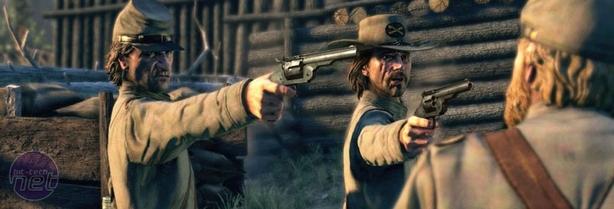
Call of Juarez: Bound in Blood Preview
Publisher: UbisoftPlatform: PC, Xbox 360, PlayStation 3
Release Date: June 2009
The original Call of Juarez was, we must admit, a game that mostly passed us by. While Techland did have a fair bit of graphical beef behind its new engine, the gameplay itself was somewhat unimpressive and the constant uncontrollable hopping between the two protagonists left us feeling disconnected and at odds with the plot.
There was the Reverend Ray, the gunslinger turned preacher who was all about the special-moves and quick-draw firepower and then there was Billy, the drifter with a whip who was more suited to the stealthy side of things. On paper the idea of hopping the player between the two was a great way to keep things feel fresh, but in reality you’d always just got used to one when the game pulled a switcheroo on you and moved you to a less-likeable persona.
The first thing that Call of Juarez: Bound in Blood does is remedy that, though it doesn’t do it by trimming down the cast as you might expect. There are still two characters and they still represent the choice between assault and evasion, but now the choice is left open to the player. If you don’t like the idea of stealth-ifying your way across a battlefield then Bound in Blood won’t force you unless the twists of the plot separate the two main characters.
The two protagonists in question are, of course, the McCall brothers. Bound in Blood is a prequel to the first game and Ray, who you’ll remember later becomes a small-town preacher, hasn’t yet got into the habit, if you’ll excuse the pun. He’s still full of fire and evil, but this time he’s joined by his little brother Tom. Ray is still the power-house of the game thanks to his crucifix-emblazoned cuirass, while Tom is of the more subtle sort and depends more on his rifle for sniping the opposition.
The plot for the game once again centres around the lost treasure of Juarez, supposedly a massive hoard of Aztec gold. Ray and Tommy, who start the game as soldiers in the American Civil War, decide to try and salvage the hidden fortune after stumbling across some information in the course of duty. The hunt for the gold quickly becomes an obsession for the brothers, naturally – one which ends semi-tragically in the finale to the first Call of Juarez.
Opposing the pair o’ frères though is their old commanding officer, who holds the two as military deserters and, indirectly, considers them responsible for all manner of other evils. Ready to destroy anything in his path in order to get at the McCalls, the Colonel is oblivious to the fact that he’s committing far worse atrocities of his own, which makes him come off as all the more evil and despicable.
In any other game this demented soldier-without-a-war would come across as a stereotype or ridiculous exaggeration, but Techland obviously felt that an extra-evil bad guy was needed in order to make the good guys seem righteous. Ray and Tom are hardly likeable, honest men at the best of times, so they need to be opposite someone truly detestable in order to stop the game feeling like a round of Dungeon Keeper.
At a glance then, Techland may have nailed down the one idea that makes all spaghetti westerns so good; the idea that there aren’t any real good guys at all, just various different dilutions of the devil. Ray and Tommy might well try to protect some of those who fall across the Colonel’s path, but that doesn’t make them any less malevolent. They’re still bastards at heart – but aren’t we all?
Nope? Just us then.

MSI MPG Velox 100R Chassis Review
October 14 2021 | 15:04











Want to comment? Please log in.